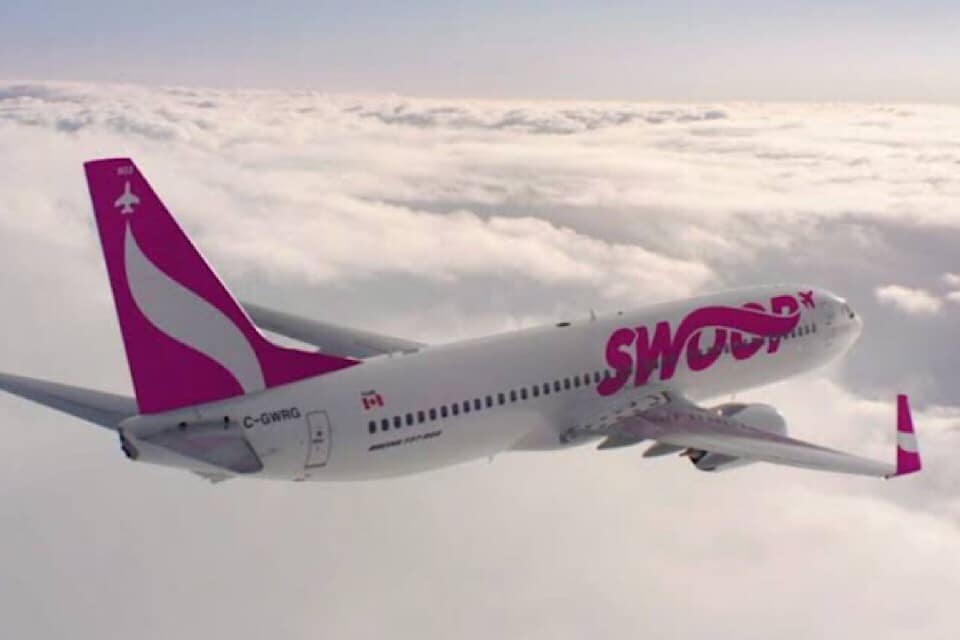Aviation
April 1 Alert: Swoop brings lie-flat seats to its single class cabin

An industry leader in innovation, Swoop breaks the mould on the ultra-low-cost model with its Recline-for-a-Dime™ product
CALGARY, April 1, 2019 /CNW/ – Swoop has set a new bar in ultra-low-cost unbundling with the introduction of its Recline-for-a-Dime™ product. The feature, expected to be configured across the fleet by the end of April 2019, allows travellers to insert a dime into the armrest of their seat in exchange for two-inches of 30-minute timed recline. Credit card tap is also enabled for even more convenience.
The cost to lie completely flat is $0.90, though travellers can fully customize the amount of time and the degree of recline they prefer, in $0.10 increments. When the time is up, the seat gently returns to its upright position. Swoop’s Flatter-than-Flat feature is offered for an additional $0.10, allowing travellers who have purchased the lie-flat option to further stretch their spine.
“Lie-flat luxury seating seems to be all the rage these days,” said Steven Greenway, President of Swoop. “Our travellers now have the option for a premium experience without breaking the bank. It’s a pivotal moment in the world of ultra-low-cost travel and only the beginning for product innovation at Swoop.”
Staying true to the ultra-low-cost model, Swoop cut the cost of reclining from the fare so travellers are only paying for what they use. Swoop is the only airline in the world to have the patent-pending air-worthy automated seat-recline technology.
“An innovation that truly has your back….”
For years, ULCC’s have been targeted for having cramped, unfriendly seats. Wanting to dispel this stereotype, Swoop conceived Recline-for-a-Dime™ while inadvertently discovering a few added benefits. Studies have shown that reclining at least six inches every 20 minutes on flights over 1.5 hours increases circulation and prevents thrombosis and swelling. Studies have also concluded a relationship between reclining and a reduction in jet lag. All the more reason to recline for a dime.
“It’s about dime! Recline.”
The standard degree of recline on most airlines that offer a premium economy option is eight inches. Market research has shown potential dissatisfaction from those seated behind a seat that is reclined more than this. In these cases, the non-reclining traveller can purchase Swoop’s 5-degrees-of-freedom option, which prevents the seat in front from reclining past the eight-inch satisfaction threshold.
The feedback from the cabin crew has been overwhelmingly positive. With the automated seat technology in place, gone are the days of monitoring that all seats have been returned to their upright position for take-off and landing.
Swoop expects to further develop the offering by introducing dynamic lumbar support, massage, motion-sync to streaming music and discounted recline-credits for the frequent traveller.

Aviation
COMAC Unveils Plans for the C929 to Rival Airbus and Boeing

After the success of China’s first C919 aircraft, the country is setting its sights on developing a larger plane. COMAC (Commercial Aircraft Corporation of China) has officially confirmed plans to build a widebody aircraft, marking a significant step in its aircraft lineup.
Traditionally, Airbus and Boeing dominate the widebody aircraft market, with decades of expertise in developing planes and engines capable of carrying heavy payloads. China, which currently relies on imported engines, is now aiming to challenge these giants with its own widebody jet, the C929, designed to compete with the Airbus A350 and Boeing 777.
American Airlines Is Looking for Flight Attendants: Apply Now
The C929 will be China’s first independently developed long-range widebody aircraft. It adheres to international airworthiness standards and boasts independent intellectual property rights. The baseline version is designed to seat 280 passengers and offers a range of 12,000 kilometers, catering to global demand for both regional and international air travel.
Russia, which also needs reliable narrowbody and widebody aircraft, could become a key customer for the C929. Additionally, China plans to target the broader Asian market as it continues to expand its aviation capabilities.
Close Call at Heathrow: BA Flight Narrowly Escapes Drone Collision
China’s aviation progress includes the ARJ21 (now called C909), a regional jet with 100 seats for shorter routes, and the C919, a narrowbody jet with 180 seats designed to rival the Boeing 737 MAX and Airbus A320. Both models have found increasing demand in the domestic market.
At China’s largest air show in Zhuhai, COMAC announced that Air China will be the launch customer for the C929 widebody jet, though details about order size and delivery timelines were not disclosed.
Other major deals announced by COMAC include:
- Hainan Airlines: Firm orders for 60 C919 and 40 C909 regional jets.
- Colorful Guizhou Airlines: 30 C909 jets, with 20 firm orders and 10 provisional agreements.
The C929, renamed from the CR929 after Russia withdrew from the joint development project in 2023, is expected to carry 280–400 passengers with a range of 12,000 kilometers, competing directly with Boeing’s 787 Dreamliner.
According to COMAC’s deputy general manager, Tong Yu, the first fuselage section of the C929 is expected by September 2027, with prototype test flights anticipated soon after.
-

 Aviation2 months ago
Aviation2 months agoMicrosoft Flight Simulator Raises $3 Million to Bring Back the An-225 Mriya
-

 Airlines2 months ago
Airlines2 months agoQantas Engineers Stage Walkout Over Cost of Living Concerns
-

 Airlines2 months ago
Airlines2 months agoQatar Citizens Can Travel to the United States Without a Visa
-

 Aviation2 months ago
Aviation2 months agoQatar Airways bans these new Electronic Devices on plane
-

 Airlines2 months ago
Airlines2 months agoJapan Airlines Rolls Out Free Domestic Flights to International Passengers
-

 Defence2 months ago
Defence2 months agoWhich Country Has the Largest Fleet of Fighter Aircraft?
-

 Airport2 months ago
Airport2 months agoWestern Sydney Airport Welcomes Its First Plane After 6 Years of construction
-

 Aviation2 months ago
Aviation2 months agoDid you know ? Once Boeing 747 carried 1088 passenger in 1991








